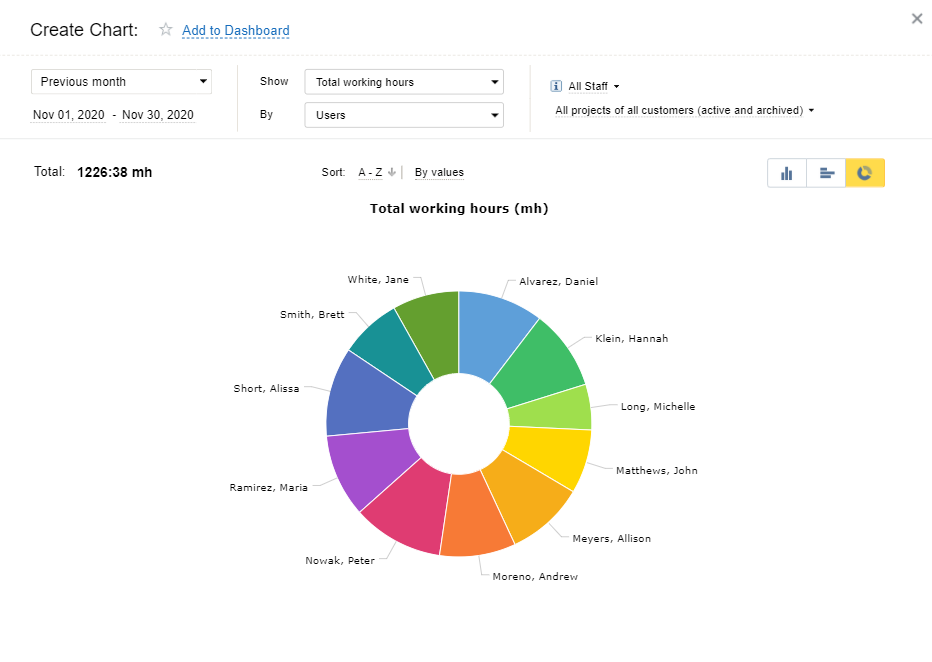
If you want to achieve remarkable business results, you need to ensure your team is productive. Plenty of useful techniques and practices are readily available to help you with that. However, applying them without measuring your team’s productivity first is of no use.
In this post, we’ll explore the most common productivity measurement methods so you can choose what’s fit your need. But first, we’ll discuss what productivity actually means (this term is a bit trickier than it sounds).
Let’s dive right in! 🏊
What Is Productivity?
There’s no universal definition of productivity.
In a generalized sense, productivity is the level of efficiency in the production process, team performance or individual behaviors. Nevertheless, it can be analyzed based on a variety of criteria, such as output, compliance with task estimates and profitability.
To implement any of them, you need merely two things:
- A clearly formulated productivity objective to compare your performance data against
- Accurately corrected data on your progress towards the set goal
Here are some more details:
📦 Output ÷ resources invested in a task
Output is any quantifiable result of your activities. If you’re a car manufacturer, it’s represented in the number of vehicles produced, and if you’re a student, as the whole of new knowledge acquired.
But whatever the form it takes for your team, the goal of productivity measurement is to divide the total volume of output by the number of resources invested in work. Based on this simple formula, the less time or money you spend on a task, the more efficient and productive you are.
However, there is no universal numeric indicator of high or low productivity. You have to find which output-resource ratio is optimal in your case, either through benchmarking or personal experience.
💰 Profit ÷ volume of resources put into a project
Not all the efforts invested in a project or task bring earnings. However, most businesses are profit-oriented. Thus, it’s useful for them to measure productivity by dividing the total of money gained by the overall amount of resources utilized.
Following this principle, if you spend hundreds of hours on an activity that brings small to zero profit, your business productivity is low. However, when high earnings are an outcome of minimum resource investment, your productivity is on top.
To make this productivity measurement method work better, be sure to track both billable and non-billable time. Even such non-billable activities as team meetings and phone calls incur costs. Hence, they inevitably affect your company’s profitability and productivity.
⏳ Task estimates ÷ number of hours worked
For many businesses, adherence to schedules is pivotal since the failure to finish work on time often leads to severe repercussions. So, if deadlines are important for you too, you may measure team productivity by comparing task estimates with the actual number of hours worked.
In this case, an employee’s inability to comply with estimates equates to low productivity. In contrast, if one completes their work just on time, it means they are efficient enough.
Note: The accuracy of your initial estimates is a significant variable in this formula. If the deadlines are unrealistic in the first place, failing to meet them is not a sign of inadequate performance. It simply means you need to improve your time estimation skills.
Key Productivity Measurement Methods
To measure productivity using any of the above formulas, you will need merely three tools:
- Cost (and profit) tracking
- Time tracking
- Productivity logs
They will help you collect objective data on team and business performance and then compare your actual results to the planned objectives or initial estimates and come to correct conclusions.
Let’s discuss these data collection methods in a bit more detail:
💸 Cost tracking
Cost tracking is a series of procedures aimed at keeping a detailed record of a business’s financial performance. These procedures include cost estimation, budgeting and cost tracking itself.
To log and monitor expenses, you may use a simple spreadsheet. However, advanced cost tracking apps offer a much more significant advantage:
- Some of them can capture your receipt information, digitalize and categorize it in a convenient way automatically.
- Others contain sophisticated functionality for analyzing business expenses and revenues and turning the collected data into clear-cut forecasts.
- There are also cost trackers with many handy accounting features, as well as those that can be integrated with specialized solutions for professional accounting.
In other words, you can find a good option for yourself without much trouble – the choice depends merely on your budget and the number of features you want your tool to have.
Note: In case you plan to measure your business productivity using the profit-cost ratio, consider adopting a software solution that can keep track of your expenses and earnings alike. The more types of costs and sources of income it can capture, the better it is for you – a more comprehensive set of data stored in a single place will simplify the productivity measurement process a great deal.
⏲️ Time tracking
Time is one of the most vital measures of productivity. The number of tasks you can complete within a certain timeframe is always limited, and you can expect to attain the maximum possible output merely if you’re super-efficient with the use of time.
The question is: how to achieve that? The answer: time tracking tools can be of help.
Time tracking software is meant to show you how well you dispose of time, how many hours you invest in every piece of work, and how the number of utilized resources corresponds with your outputs. Once you have this data in place, you can use it to promote productivity and get more efficient at work.
But how easy is it to review team productivity trends with a time tracking app? Very easy – just click a button to generate a report.
Let’s assume actiTIME as an example. It allows users to:
- Create charts showing the total working hours, leave hours, billable time, cost of work, as well as many other performance criteria
- Run regular monthly performance reports that summarize all the time tracking results for your team
- Compare your task estimates with actual time worked for any period of choice
- See how much overtime and leave time your employees had, etc.

This way, actiTIME enables you to identify any time wasters, i.e., the activities that take a lot of time but don’t result in much progress and don’t contribute to your goals. After finding all the bottlenecks and low-value tasks, you’ll be able to replace them with more productive processes without trouble.
📝 Productivity logs
A productivity or activity log is a detailed record of all the things that an employee has accomplished over time. Along with the list of tasks completed day by day, it may include the details on how much time was spent on each piece of work. And if employees are supposed to meet a specific objective every day or week – e.g., resolve 20 issues or sew together 5 teddy bears – the log should precisely capture their outputs as well.
Those who want to keep productivity logs for personal purposes can easily do that on paper. Yet, for teams, more advanced progress logging tools are required. Otherwise, managers will spend a ton of time simply organizing and processing employees’ productivity records.
Task trackers and automated activity trackers can be of immense help in this regard. So, check out this list to explore some of the best software options available on the market these days. 👇
3 Tips for Better Productivity Measurement and Improvement
🤝 Consider both individual and team productivity
As noted by Jayson DeMers, the CEO of EmailAnalytics:
“Focusing exclusively on individual productivity will blind you to the failings of the group, like inefficient processes or poor collaboration. Focusing exclusively on team productivity will blind you to the unique individual strengths and weaknesses that need to be exploited and mitigated, respectively.”
Therefore, to obtain objective information regarding the state of productivity in your company, it’s pivotal to analyze both collective and individual results.
Note: Paper timesheets and activity logs are appropriate for evaluating individual productivity. But to analyze team productivity using such old-fashioned tools, you’ll have to sum up all the numbers for different employees manually.
The same applies to many digital spreadsheets.
However, a smart time and task tracker, such as actiTIME, will readily do all the complex calculations for you and provide you with an in-depth overview of both personal and collective performance. And that’s very important.
🔎 Monitor overtime
As a manager or business owner, you would likely be pleased to see your team members staying at the office for extra hours and cracking the assigned tasks one by one during their personal time. However, the overtime rate going upwards is always a warning sign.
In the short term, it’s possible to show positive performance outcomes while focusing on professional matters for 10-15 hours each day for a week or two. But in the long term, continual overtime work is counterproductive – it causes stress and leads to burnout. In the end, it reduces motivation and depletes energy like nothing else.
Increased overtime rates are linked to many more serious problems, including the increased risk of workplace injury and detrimental effects on employees’ health. Therefore, if you care about business productivity, you have to care about your staff members as well:
- Never force overtime in excessive amounts and when unnecessary,
- Monitor how much time your workers devote to tasks per day and week,
- And encourage them to take energizing breaks in order to boost both personal and organizational productivity.
🧠 Plan your workloads
Just like overtime, excessive workloads can lead your employees to burnout. However, without enough tasks assigned to them, your workers won’t put their best effort into performance and, in the worst case, will spend a lot of time slacking off and doing nothing important.
To help yourself manage team workloads better, consider applying software with at least basic task management functionality. In actiTIME, for example, you may not only manage the work scope, create and assign tasks to responsible employees but also indicate estimates and deadlines for different pieces of work. Knowing how much time it will take your staff members to complete each task, you will allocate just the right number of duties to them per certain period. And to acquire accurate task estimates, you may implement actiTIME as well.
Use the data on your previous task and project performance to identify how many hours you need to invest in your future similar tasks. This process is called estimation by analogy, and you can learn more about how to apply it with the help of actiTIME here.
Conclusion
Time, money and employee activities are the three crucial variables in your company’s productivity formula. For better productivity measurement, you have to analyze and compare them to your objective results: profit, output and ability to meet the initial estimates.
Need a solution that can help you log activities, track time and monitor staff-related expenses in a single place? actiTIME is an excellent option! ✨
actiTIME is more than just a tool for collecting info about your employees’ use of time. It streamlines the process of productivity measurement and includes such features as reporting and task management that let you plan workloads and monitor overtime and revenues with ease. Doing all that, actiTIME informs your decision-making and helps to adopt effective strategies for boosting productivity.
And aren’t these valid reasons to try it out?











































